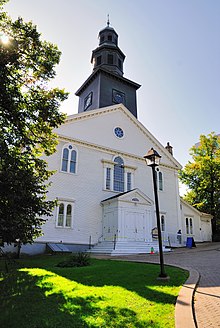St. Paul's Church (Halifax)
The St. Paul's Church in downtown Halifax is the oldest Protestant church in Canada.
history
With the proclamation of King George II , the community was founded in 1749. The church was built in the summer of 1750 and opened on September 2nd of the same year.
The blueprint of the church is based on St Peters Church on Vere Street in London , designed by James Gibb in 1722. Although a new facade to the north, a larger church tower , two side aisles in 1868 and the choir in 1872 were added, the two sacred buildings are similar. The lumber for St. Paul's Church comes from Boston and came to Halifax by sea. The foundation walls are made of bricks that were made locally.
With the arrival of Charles Inglis as the first Anglican bishop of Nova Scotia in 1787, St. Paul's Church rose to become a cathedral and remained so until 1865. At the same time, St. Paul's was the first garrison church in Halifax until a garrison chapel was built in 1844 . St. Paul's Church continues to function as a parish church for the Anglican Church of Canada .
description
After the vestibule, there are showcases in the back of the main nave that depict important events in the history of this church.
The large number of memorial plaques inside the church is remarkable . They commemorate personalities who have an important place in the history of Nova Scotia and Halifax. The oldest of the tablets are on the side wall of the chapel.
In the baptistery there are two baptismal fonts made of alabaster stone . The lids of the basins are decorated with a dove. To the left of the basin is an old wooden sacrificial box.
organ
The organ from 1908 was restored between 1947 and 1960. It is the fifth organ in the church and the second in the choir . The original organ is said to have been bought in 1765 from the cargo of a captured Spanish ship. Two angels on the back wall of the gallery are part of the original organ, which was made of mahogany . The instrument has 48 stops (two of which are transmissions) on four manuals and a pedal . The playing and stop actions are electro-pneumatic.
|
|
|
|
|
|||||||||||||||||||||||||||||||||||||||||||||||||||||||||||||||||||||||||||||||||||||||||||||||||||||||||||||||||||||||
Web links
- Website of the St. Paul's Church (Engl.)
Individual evidence
- ↑ St. Paul's Anglican Church (Eng.)
- ↑ List of the Bishops of the Diocese of Nova Scotia and Prince Edward Island
- ↑ More information about the organ
Coordinates: 44 ° 38 ′ 50.7 " N , 63 ° 34 ′ 28.4" W.
